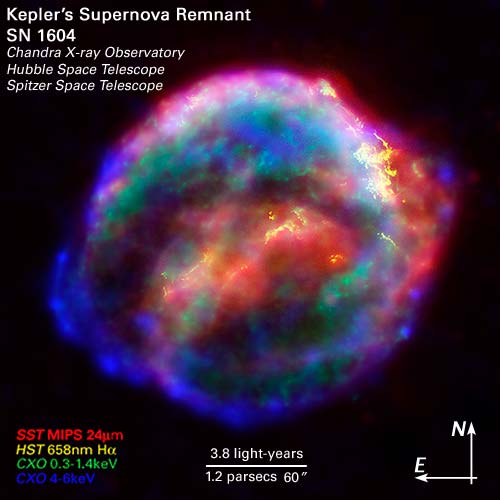
|
Credit & Copyright: courtesy STScI
Explanation:
Light from the stellar explosion that
created this energized cosmic cloud was first seen on planet
Earth in October 1604, a mere
four hundred years
ago.
The supernova produced a bright
new star
in early 17th century skies within the constellation
Ophiucus.
It was studied by astronomer
Johannes Kepler
and his contemporaries, with out the benefit of a telescope, as they
searched for an explanation of the heavenly apparition.
Armed with a
modern
understanding of stellar evolution,
early 21st century
astronomers continue to explore the
expanding debris cloud, but can now use
orbiting space telescopes to
survey Kepler's supernova remnant (SNR)
across the spectrum.
In this tantalizing composite image,
x-rays,
visible light, and
infrared
radiation recorded by NASA's astrophysical
observatories - the
Chandra X-Ray Observatory,
Hubble and
Spitzer
space telescopes - are combined to give a more comprehensive
view of the still enigmatic supernova remnant.
About 13,000 light years away,
Kepler's supernova
represents the most recent stellar explosion seen to
occur within
our Milky Way galaxy.
|
January February March April May June July August September October November December |
| ||||||||||||||||||||||||||||||||||||||||||||||||
NASA Web Site Statements, Warnings, and Disclaimers
NASA Official: Jay Norris. Specific rights apply.
A service of: LHEA at NASA / GSFC
& Michigan Tech. U.
Based on Astronomy Picture
Of the Day
Publications with keywords: supernova - supernova remnant - kepler - optical - infrared
Publications with words: supernova - supernova remnant - kepler - optical - infrared
See also:
- APOD: 2025 October 1 Á NGC 6960: The Witchs Broom Nebula
- APOD: 2025 July 31 Á Supernova 2025rbs in NGC 7331
- APOD: 2025 June 9 Á Between Scylla and Charybdis: A Double Cosmic Discovery
- APOD: 2025 February 23 Á Saturn in Infrared from Cassini
- Supernova Remnant Cassiopeia A
- APOD: 2025 January 8 Á Supernova Remnants Big and Small
- APOD: 2024 September 18 Á The Mermaid Nebula Supernova Remnant
